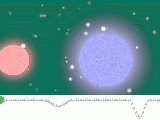Exoplanets
Exoplanets are planets orbiting another star than our Sun. In order to detect an exoplanet, astronomers need to use indirect methods because the planet itself does not produce any light and reflects only a very tiny amount from the star it is orbiting. One of these methods, the transit method, records the extremely tiny variations in stellar brightness that occur when the planet passes precisely in front of the stellar disk.
This phenomenon is called an eclipse (or transit). As viewed from Earth, it is very similar to when a planet of our solar system (e.g. Mercury) passes in front of the solar disk
during its periodic orbit around the Sun.
Because the stars are much further away and the planets are so small, this short and minuscule attenuation of the starlight is very difficult to measure from the Earth's surface.
That's why satellites are being used, such as e.g. CoRot (2006) and Kepler (2009).
So far, more than 1000 exoplanets have been discovered and confirmed (see the Kepler website).
Moreover, some of these recently discovered exoplanets have an orbit in the star's "habitable zone", i.e. a zone where certain substances could exist as liquids for a longer time
(e.g. similar to water on Earth).





